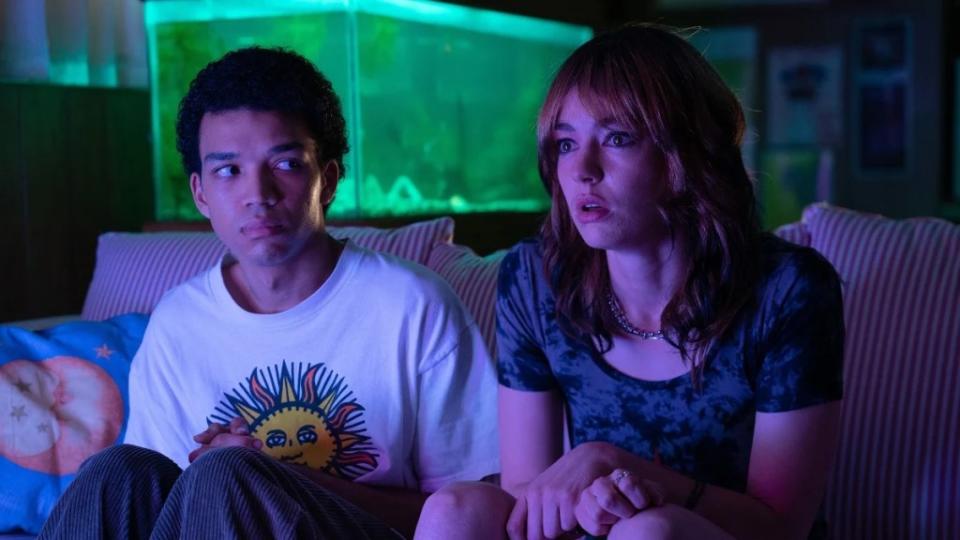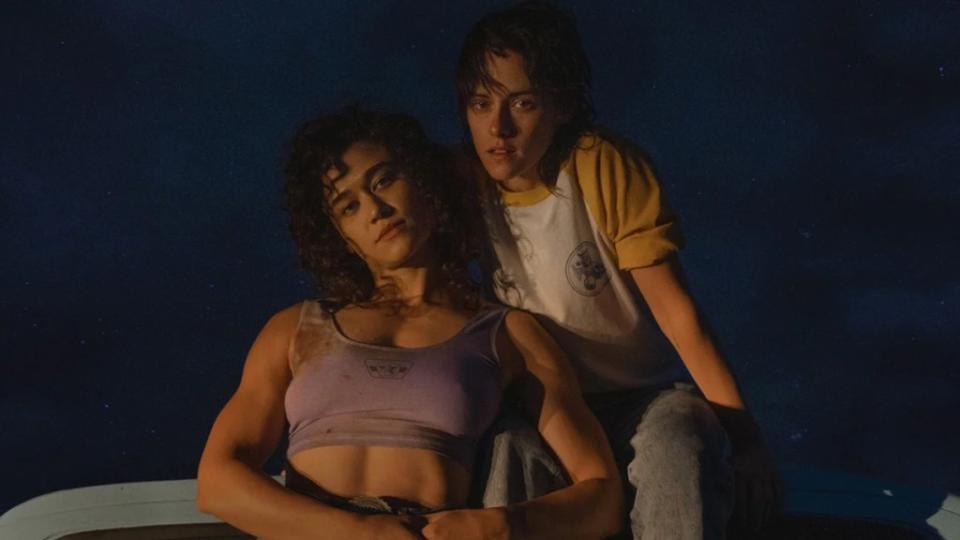Genre Rules Sundance So Far: Blood, Guts and Sex-Filled Movies Tackle Social Issues
- Oops!Something went wrong.Please try again later.
- Oops!Something went wrong.Please try again later.
The buzziest movies of the Sundance Film Festival so far speak to a new trend in indie cinema: social commentary packaged as genre films.
The Pedro Pascal-led “Freaky Tales,” playing in the premieres section, is a hyper-violent, VHS-era romp that’s also about the rise of neo-fascist groups in Oakland in the 1980s.
A24’s trippy “I Saw the TV Glow” is a dreamlike allegory about the trans experience, which follows two teens so uncomfortable in their own skin that they long for the world of a fictional “Buffy the Vampire Slayer”-esque TV show to be their reality.
“Sasquatch Sunset” finds Jesse Eisenberg and Riley Keough playing the hairy creatures in a tale that’s ultimately about the destruction of the environment. The film takes on the look and feel of a pseudo-nature documentary, as we see the sasquatch in their natural habitat, but slowly reveals more layers as they explore habitats that have been impacted by mankind.
“The American Society of Magical Negroes,” a social satire written and directed by Kobi Libii, spins a tale of magical realism around notions of race, where a Black secret society intervenes to alleviate white discomfort – with the ultimate goal of keeping Black people safe.
Genre films – sci-fi, fantasy, horror or other highly stylized narratives – are not new to Sundance, of course. But the format has moved from midnight sections of previous decades to the main competition, where movies considered to be more artistically serious get the highest profile. The shift might reflect changing tastes, or reflect the success of mainstream genre films with social themes, from Jordan Peele’s “Get Out” to Academy Award winner “The Shape of Water” by Sundance alum Guillermo del Toro.
“I Saw the TV Glow,” about teens (Justice Smith and Brigette Lundy-Paine) who bond over their shared love of a TV show, was inspired by writer-director Jane Schoenbrun’s own obsessive fandom over the beloved 1990s horror fantasy series “Buffy the Vampire Slayer.” The film draws from David Lynch’s style to offer nightmare-inducing imagery that may or may not actually be happening. To wit, a character puts his head inside a television as a horrific sound bursts through the screen, then is seemingly fine in the next scene.
Schoenbrun, who is a trans filmmaker, told TheWrap that the visually arresting feature is ultimately a tale about being queer as these two characters yearn for any kind of escape from their mere existence. “It’s much more about feeling so in love with a television show because you’re not able to be present and be yourself in the real world,” they said.
“Freaky Tales,” on the other hand, is an Oakland-set thriller, part anthology, part loving ode to the 1980s, bathed in blood and soundtracked by an all-star collection of eclectic (and decade-appropriate) tunes. Divided into four chapters, each with its own visual style, the film follows a pair of young punks beset by bullying Nazis, a female rap duo trying to find their big break, a regretful enforcer doing one last job and a heist plot involving Los Angeles Laker Sleepy Floyd (played in the film by Jay Ellis).
But it’s also about Nazis, racism and the abuse of power by police.
Co-director Anna Boden told TheWrap that the film’s gleefully violent approach to tackling these issues was in seeking a more light-hearted space to depict the rise of hate-driven violence.
“There is violence in this movie and I’m not a huge fan of violence. I’m a very non-violent person,” she said. “But there is something about, over the past few years, the anger that people have felt about so much hatred-fueled violence that’s in the world. For us, I think it felt very cathartic to explore — in a very safe place, like a movie — a little bit of a revenge fantasy against that hate-fueled violence.”
Boden’s co-director Ryan Fleck said they were inspired to include a battle with neo-Nazis in the film due to the rise of fasicist groups like the Proud Boys during the Trump era.
“It feels like we grew up and our parents grew up on movies where everyone could agree the Nazis were the bad guys. It wasn’t controversial. Liberal, conservative, we all knew who the bad guys were,” he told TheWrap. “Now it feels like it’s become infused with this grey area where people are starting to wonder and ‘there are fine people on both sides.’ And we were like, ‘No, the f–king Nazis are the bad guys and they’re gonna get it!’ And we light them on fire.” (In one case, literally.)
There are still plenty of more traditional dramas and comedies playing in the festival this year, including “A Real Pain” written and directed by Jesse Eisenberg, which sold to Searchlight Pictures for $10 million on Sunday. That decidedly linear film depicts two cousins, Eisenberg and Kieran Culkin, who trace their family origins in Eastern Europe and explore the Holocaust.
Eisenberg told TheWrap the movie sprung from his desire to explore his own anxiety at a time of relative safety and privilege, and guilt over not appreciating what his ancestors had to endure.
“Why shouldn’t I be … running and skipping?” he said at TheWrap’s interview studio. “Why do I have my head down? Why am I miserable?” The movie explores what he called his generation’s “petty grievances against the backdrop of a concentration camp.”
The comedy “Between the Temples,” which got strong reviews, stars Carol Kane and Jason Schwartzman as a teacher seeking late in life bat mitzva training with her former student, Cantor Ben (Schwartzman), who is having a crisis of faith.
And the US Dramatic Competition film “Didi” by writer-director Sean Wang is a a classic Sundance coming-of-age film, about a Taiwanese-American teenager, struggling his way to adulthood in multi-cultural Fresno. That too has had pre-festival sales buzz and strong reviews.

Boden and Fleck are Sundance regulars, having previously come to the festival with dramatic darlings like “Half Nelson” and “Mississippi Grind.” They made the jump to blockbusters with 2019’s Marvel film “Captain Marvel” like so many other filmmakers who broke out at Sundance (see: Ryan Coogler, Jon Watts and Chloe Zhao). Their return to the festival with a genre-baked indie could set a trend of its own.
“Sasquatch Sunset” is one of the festival’s boldest (and most divisive) movies. Ostensibly, it’s about a family of sasquatches (played under elaborate make-up by Eisenberg and Keough). We watch as they eat and fight and throw their poop at birds. It’s both sophomoric and soulful. And when you realize that the movie is wrestling with weightier themes – about the destruction of the environment, the encroachment of man into nature, and indeed what makes us human, as the female sasquatch must defend herself from horny males – it makes “Sasquatch Sunset” seem like an even greater, more audacious accomplishment.
“There was no way to avoid it,” David Zellner, one of the directors of “Sasquatch Sunset,” told TheWrap of the film’s socio-political themes. “If what we’re trying to do is an accurate portrayal of this world that they’re in, that’s inherently part of it. It was important to have that be as much an element of it as anything else.” In other words: you couldn’t have zany sasquatch action without the undercurrents about conservation and environmentalism.
Keough pointed to a moment when the sasquatch family stumbles upon a fire, its rich, billowy smoke clouds cutting through the natural beauty of the forested landscape. “When we were shooting that, I really felt the weight of it,” Keough told TheWrap, about the movie’s conservationist themes.
Even films tackling race at this year’s Sundance film festival are leaning into genre. Focus Features release “The American Society of Magical Negroes” tackles race through the prism of mystical satire, as the film starring Justice Smith (yes, again) follows a secret society of African-Americans whose job is to make the lives of white people easier. “We need to be talking about race in new and different ways,” director Libii told TheWrap.
And “Presence,” Steven Soderbergh’s whirligig horror feature told from the point of view of a ghost, deals with issues of generational trauma, consent and the place of a mixed-race family in a predominantly white society. In fact, during one of the screenings of the movie at the festival, an audience member got up and told Soderbergh and writer David Koepp how triggering the movie was for her. The filmmakers listened thoughtfully and remarked that the scary things in their movie also scare them.
Sundance was jolted to life on Saturday with the premiere of “Love Lies Bleeding,” an unapologetically kitschy film noir starring Kristen Stewart, shot through with childhood trauma, gay sex and extreme violence. Co-writer/director Rose Glass examines gender politics, sexual fluidity and the power dynamics between men and women, while still delivering nail-biting shootouts and splashes of body horror.
Stewart plays a small town gal who works at a gym and who despises her creepy, gun-runner father (a snarling Ed Harris). One day she falls in love with a female body builder drifting through town (Katy O’Brian) and their world soon descends into bloodshed and betrayal. (It also includes what is arguably the most satisfyingly graphic movie murder in quite some time.)
The film will be distributed by cool kid arthouse A24 later this spring.

One reason for the rush into genre film for independent filmmakers might be that the format is making money. Small budgets and unknown casts can still prove lucrative. Take “Five Nights at Freddy’s,” an adaptation of a cult video game made for $20 million by Blumhouse and Universal, which grossed nearly $300 million even though it simultaneously premiered on Universal’s direct-to-consumer streaming service Peacock. Similarly “Smile,” which was made for $17 million and featured a cast of below-the-radar talent and a filmmaker making his debut, based on an original property, made more than $200 million worldwide. And A24 continues to find success in genre — the studio scooped up “Talk to Me” in a bidding war at Sundance in 2023 and it went on to gross nearly $100 million worldwide last summer.
Sundance 2024: the same indie sensibilities. But this time, covered in blood.
Check out all our Sundance coverage here
Adam Chitwood contributed to this story.
The post Genre Rules Sundance So Far: Blood, Guts and Sex-Filled Movies Tackle Social Issues appeared first on TheWrap.

